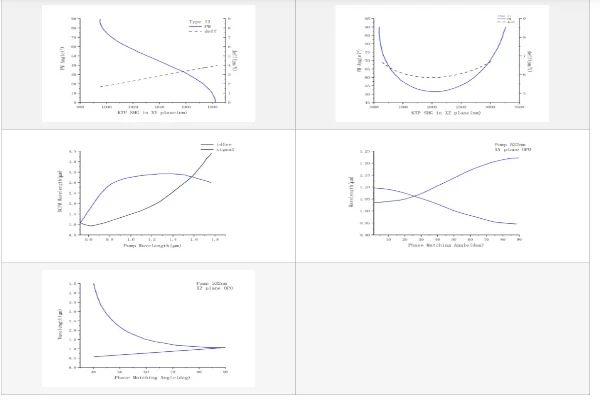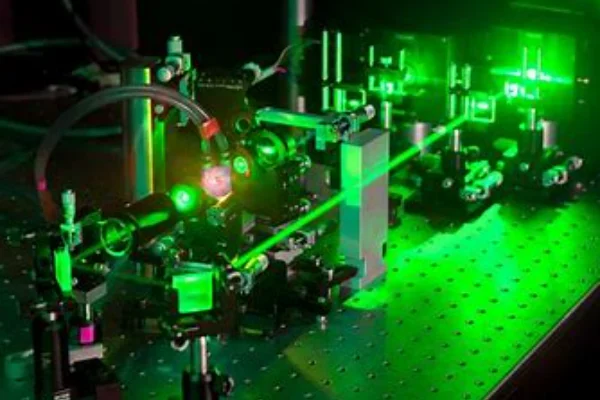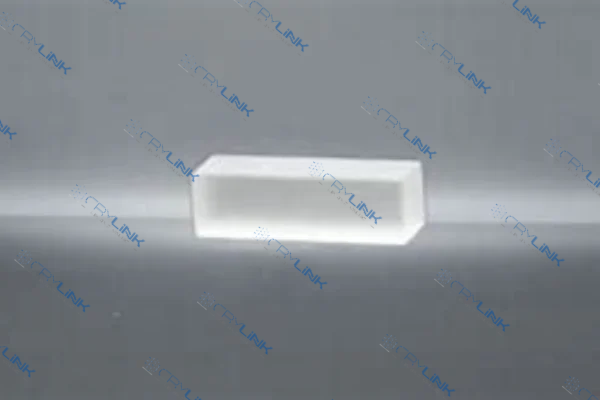Introduction
When it comes to nonlinear optical applications, both HGTR-KTP (Highly GeO2-doped Titanyl Phosphate) and traditional KTP (Potassium Titanyl Phosphate) crystals have proven indispensable. However, the differences between these two materials are notable. In this comparative analysis, we’ll delve deep into the characteristics of HGTR-KTP and traditional KTP, examining their nonlinear coefficients, temperature acceptance bandwidths, and optimal phase matching conditions.
Overview of HGTR-KTP Crystals
KTP crystals, recognized in the chemical world as KTiOPO₄, have etched a prominent space in the domain of optics and laser technologies. These crystals are especially acclaimed for their role in the frequency doubling of solid-state lasers. What makes the traditional KTP stand out is its unparalleled phase-matching attributes, which are pivotal in laser applications. Such is the efficiency and reliability of traditional KTP that its performance remains steadfast across a plethora of temperature gradients, assuring users of its dependability in diverse operational environments.
However, in the ever-evolving world of photonics, there’s an innovative version of KTP that’s making waves—HGTR-KTP. This iteration is not just an enhancement of the traditional crystal but is distinctively refined with a higher concentration of germanium oxide (GeO2). The process of doping this crystal with GeO2 is not a mere cosmetic enhancement. It catapults the crystal’s intrinsic properties, giving it a significant edge, especially when delving into high-intensity power applications.

Imagine the robustness of a traditional KTP, and then envision it being supercharged to handle even more intensive tasks—that’s HGTR-KTP for you. This germanium oxide-doped version is not just about power; it’s about finesse. Its advanced properties enable it to be more efficient and offer a wider range of adaptability in specific applications that might have been challenging for the traditional KTP. It’s akin to having a versatile tool in your arsenal that’s not only powerful but is also precision-oriented, ensuring that even the most nuanced of tasks are executed with unparalleled perfection.
In essence, while the traditional KTP continues to be a stalwart in the optics arena, HGTR-KTP is fast emerging as the go-to choice for those seeking enhanced efficiency coupled with versatility. Whether you’re an industry professional or a researcher aiming to push the boundaries in laser technologies, understanding the nuances and capabilities of these two variants can pave the way for breakthroughs and innovations.
-crylink.webp)
Nonlinear Coefficients: A Closer Look
Nonlinear coefficients play a pivotal role in the optics world, serving as indicators of how materials interact with light in non-linear processes. Within this context, Traditional KTP has long been esteemed for its remarkable nonlinear optical attributes. A testament to its capabilities is the effective nonlinear coefficient, denoted as d_eff. This coefficient stands typically around the 8.3 pm/V mark, specifically when it comes to frequency doubling of the widely-used 1.064 μm Nd:YAG laser. Such a value underscores the proficiency of traditional KTP in managing complex optical tasks, marking it as a reliable player in a plethora of laser applications.
However, as the adage goes, there’s always room for improvement. Enter HGTR-KTP. Infused with germanium oxide (GeO2), this variant of KTP not just matches but also elevates the benchmarks set by its traditional counterpart. The introduction of GeO2 doesn’t merely serve as an additive; it transforms the fundamental properties of the crystal. This metamorphosis gives HGTR-KTP a definitive edge in its nonlinear coefficients. Although the exact coefficient values are influenced by the concentration of the dopant, one overarching theme remains consistent—HGTR-KTP generally outshines traditional KTP in this regard.
This superiority isn’t just about numbers on a scale; it translates to tangible advantages in real-world applications. A heightened nonlinear coefficient implies that HGTR-KTP can facilitate more efficient interactions with light in nonlinear optical processes. Picture a scenario where every ounce of efficiency counts, where precision is paramount, and where there’s little margin for error. In such settings, the elevated coefficients of HGTR-KTP can make all the difference, offering enhanced performance and ensuring desired outcomes with greater consistency.
To draw a parallel, think of the nonlinear coefficient as the engine power in vehicles. While a car with decent horsepower can traverse most terrains with ease, one with greater horsepower can not only navigate the same terrains but can also tackle more challenging paths, offering more power, speed, and efficiency. Similarly, while traditional KTP continues to be a robust and reliable “vehicle” in the optics domain, HGTR-KTP, with its heightened nonlinear coefficients, emerges as the high-performance variant, ready to tackle even more demanding optical challenges.

Temperature Acceptance Bandwidths
Temperature acceptance bandwidths hold a crucial role in determining the performance of optical crystals. For traditional KTP, this bandwidth is somewhat constricted. In layman terms, it’s akin to walking on a tightrope. The crystal requires a finely maintained temperature balance to ensure that it delivers its best. Even a slight swerve from this equilibrium, metaphorically akin to a misstep on the tightrope, can lead to diminished efficiency. This makes the deployment of traditional KTP a meticulous process, demanding precise temperature controls to harness its full potential.
On the other end of the spectrum lies HGTR-KTP, a game-changer that has significantly broadened the horizons of temperature acceptance bandwidths. The infusion of GeO2 into this crystal is a transformative touch. Rather than walking a tightrope, HGTR-KTP enjoys the liberty of a wide pathway.
This translates to a far more expansive temperature range within which the crystal can operate without compromising on its efficiency. Such flexibility is invaluable in real-world scenarios where maintaining a strict temperature can be challenging. Whether it’s due to the inherent design of an application or external environmental factors that introduce temperature variances, HGTR-KTP stands resilient. It promises consistent performance, unfazed by fluctuations that might deter its traditional counterpart.
In essence, the broader temperature acceptance bandwidth of HGTR-KTP is not just a numerical advantage. It’s a practical benefit that can drastically reduce the complexities of system design and operation, making it a preferred choice for scenarios demanding adaptability and consistent output. Just as a seasoned traveler would opt for a versatile vehicle capable of traversing varied terrains, an optical expert would likely lean towards HGTR-KTP for its ability to weather diverse temperature landscapes with grace.

Optimal Phase Matching Conditions
Optimal phase matching conditions are paramount in the world of optics, serving as a linchpin for achieving desired light interactions within a crystal. Traditional KTP, in its essence, stands as a testament to simplicity and reliability. Its inherent properties allow it to achieve phase matching with minimal fuss, negating the need for rigorous angular controls. This ease of integration is what endears it to many optical systems, ensuring smooth operations with reduced calibration efforts.
On the other hand, HGTR-KTP, bolstered by its refined structure, elevates this game of phase matching. It not only matches the capabilities of its traditional counterpart but goes a step further, offering a wider spectrum of conditions under which phase matching can be realized. This unparalleled flexibility makes HGTR-KTP indispensable for cutting-edge optical endeavors, where precision and adaptability in phase matching are not just preferred but imperative.
Comparative Advantages
When we place Traditional KTP and HGTR-KTP side by side, a vivid tapestry of comparative advantages emerges. HGTR-KTP emerges as a beacon of versatility, thanks to its expansive temperature acceptance bandwidth and superior nonlinear coefficient, making it a prime candidate for a wide array of applications.
Additionally, its inherent attributes lend it a higher efficiency quotient in numerous optical procedures, setting it a notch above its traditional counterpart. Perhaps the most striking edge of HGTR-KTP lies in its adaptability. With a more expansive realm of phase matching conditions at its disposal, it seamlessly integrates into varied optical systems, mitigating the necessity for intricate calibrations and adjustments.

Potential Limitations
The realm of optics and laser technology has witnessed the evolutions of various materials, each coming with its own set of advantages and challenges. HGTR-KTP, with its advanced features and capabilities, stands out as a testament to innovation. However, every innovation comes with its price tag.
The complex doping processes, combined with the premium materials like germanium oxide, understandably elevate its cost, making it a more substantial investment compared to traditional KTP. On the flip side, traditional KTP, having anchored its presence in the industry over the years, enjoys the benefits of widespread recognition and adoption. Its longstanding tenure means that manufacturers and suppliers have streamlined its production and distribution, making it more readily available across different regions. As professionals and researchers look to source these crystals, they often find themselves weighing between the superior functionalities of HGTR-KTP and the cost-effectiveness and accessibility of the traditional KTP, mapping out the best fit for their specific needs and projects.
Conclusion
Both HGTR-KTP and traditional KTP offer unique advantages in the realm of nonlinear optics. While traditional KTP is time-tested and widely available, HGTR-KTP, with its doped properties, brings to the table enhanced efficiency, versatility, and adaptability. Choosing between the two would largely depend on the specific requirements of the application in question.
Frequently Asked Questions
- What is the primary difference between HGTR-KTP and traditional KTP?
HGTR-KTP is doped with a higher concentration of germanium oxide (GeO2) compared to traditional KTP, enhancing certain properties like nonlinear coefficients and temperature acceptance bandwidths. - Why is temperature acceptance bandwidth important?
A broader temperature acceptance bandwidth means the crystal can perform optimally under a wider range of temperatures, making it resilient to fluctuations. - Which crystal is more efficient in nonlinear optical processes?
While both crystals are efficient, HGTR-KTP generally has a higher nonlinear coefficient, leading to improved efficiency in certain optical processes. - Is HGTR-KTP more expensive than traditional KTP?
Due to the doping process and the materials used, HGTR-KTP might come with a higher price tag compared to traditional KTP. - Can I replace traditional KTP with HGTR-KTP in my existing setup?
While HGTR-KTP offers certain advantages, the feasibility of replacing traditional KTP depends on the specific requirements and configurations of your optical system.

Frank
Frank graduated from the University of Shanghai for Science and Technology, majoring in optics. As a technical engineer at Crylink Company, he deeply understands crystal materials and laser components.
Related Video(s) with this Article
Related Product(s) with this Article
Related Application(s) with this Article
